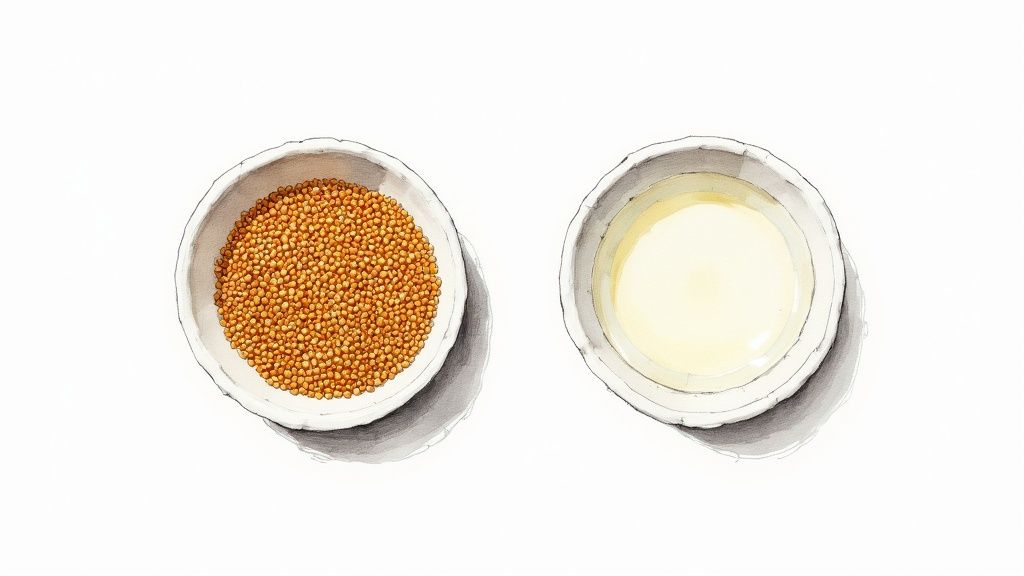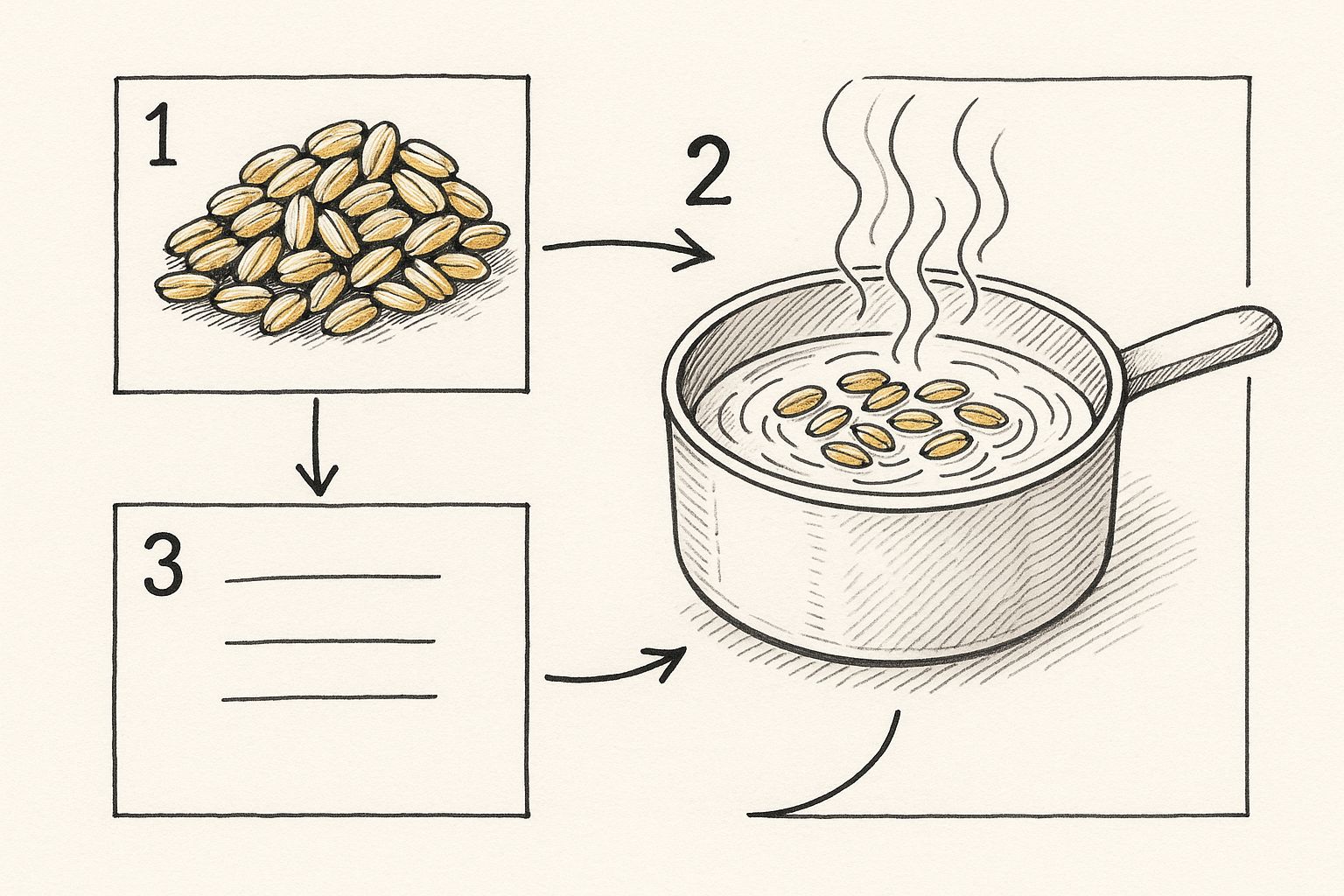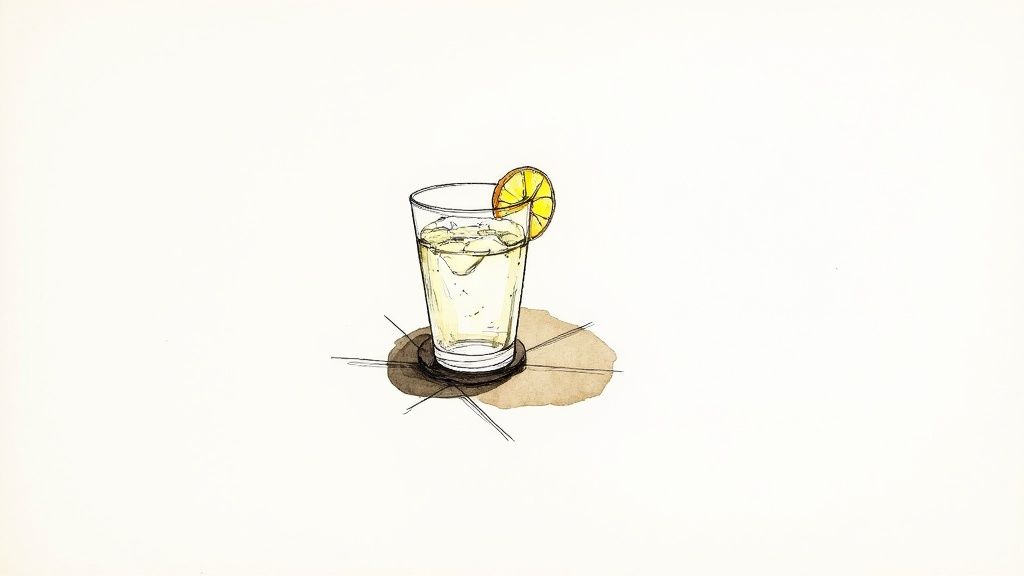Easy Recipe for Barley Water | Refresh and Hydrate Fast
Discover a simple recipe for barley water that boosts hydration and wellness. Perfect for a refreshing, healthy drink in minutes!
Posted by
So, you're curious about barley water? Good, you've come to the right place. The classic method is wonderfully simple: simmer one part pearl barley in about five to six parts water. Let it go until the grains are tender, then strain off the liquid. A little squeeze of lemon or a spoonful of honey is all it needs.
Why Barley Water Is So Popular
Let’s talk about barley water. If you’re searching for a drink that’s simple, soothing, and incredibly hydrating, you’ve found it. This isn't some fleeting health fad; it's a timeless beverage that people have been enjoying for centuries all over the world.
At its core, it's just the liquid left over from boiling barley grains. This straightforward process has deep historical roots, tied to barley's role as a fundamental crop across countless cultures. To give you an idea of its scale, global barley production hit around 154.9 million metric tonnes in 2022. It’s a testament to how important this grain really is. You can learn more about global barley production on Wikipedia.
Picture it: a cozy, warm mug on a chilly evening or a tall, iced glass on a hot summer day. It's incredibly versatile and a breeze to make with ingredients you likely already have on hand.
The real beauty of barley water lies in its simplicity. It’s a gentle, hydrating drink that you can easily weave into your weekly routine without any fuss or complicated prep.
For anyone trying to get a better handle on their nutrition, starting small is the secret. Tracking a homemade drink like this is a perfect first step. You don't need to get bogged down with precise measurements. Just tell munchlog.ai, "I had a glass of homemade barley water," and the app will handle the details. It’s an effortless way to keep an eye on your hydration and build a healthy habit—your first easy win in understanding what you're putting into your body.
A Quick Look at the Nutrients
While it's mostly water, the simmering process coaxes out some beneficial nutrients from the barley grains. This gives you a bit more than you'd get from plain water.
Here’s a simplified breakdown to give you a general idea of what's in a cup.
Quick Guide to Barley Water Nutrition
| Nutrient | Estimated Amount | Why It Matters |
|---|---|---|
| Calories | ~10-20 kcal | A very low-calorie option for hydration. |
| Carbohydrates | ~3-5 g | Provides a small, gentle energy boost. |
| Fiber (Soluble) | ~0.1-0.3 g | Supports digestive health and can help you feel full. |
| Key Minerals | Traces of Magnesium, Manganese, and Selenium | These contribute to bone health, metabolism, and antioxidant defense. |
This table provides a quick, at-a-glance look at the nutritional profile of a standard 1 cup serving of unsweetened barley water.
Remember, these are just estimates. The final numbers will shift depending on how much barley you use and how long you cook it. But for quick tracking with an app like munchlog.ai, this gives you a solid starting point.
Making Your Own Barley Water at Home
Ready to give it a go? Making your own barley water is surprisingly straightforward. Forget complicated recipes—this is all about simple ingredients and nourishing results. Let's walk through the process, from picking the right grain to the final, gentle simmer.
You'll first need to decide between pearl barley and hulled barley. Pearl barley is what you’ll find in most grocery stores. It cooks faster because the outer husk has been removed, which gives you a clearer, smoother drink. Hulled barley, on the other hand, keeps its bran layer, packing a bit more fiber but taking longer to cook. For this guide, we'll use the classic and more accessible pearl barley.
How to Get the Simmer Just Right
Here’s the simple method I use to brew a perfect batch every time.
- Give the Grains a Quick Rinse. Start with a half-cup of pearl barley. Just run it under some cool water in a strainer to wash off any dust.
- Combine and Bring to a Boil. Pop the rinsed barley into a pot with about six cups of water. Bring the mixture to a rolling boil, then immediately turn the heat down to low.
- Let it Gently Simmer. Now, just let it simmer for 20-25 minutes. You’re not looking for a specific endpoint—it’s a very forgiving process. The water will turn a bit cloudy, and the barley grains will look soft and plump. That’s when you know it's done.
- Strain and Let it Cool. Carefully pour the liquid through a fine-mesh strainer into a pitcher or jar. Don’t toss that cooked barley! It’s fantastic in soups, stews, or even a hearty salad. Let the water cool down before you drink it.
And that's it. You've just created a wonderfully simple, hydrating beverage from scratch.
Tracking Your Homemade Brew with Ease
Now for the easy part: logging it. Instead of getting bogged down with manual entries, you can just tell your app what you made.
For instance, a simple voice command like, "I made barley water from a half-cup of barley," is all munchlog.ai needs to estimate the nutrition for you. It’s a great way to stay mindful of what you're consuming without the usual hassle of tracking homemade recipes. This approach is far less tedious than weighing every ingredient, and you can learn more about the pros and cons of using a food scale to decide what's right for you.
The goal is effortless awareness, not perfect precision. A simple voice command keeps you on track without pulling you out of your daily flow.
It’s interesting to think about where our barley comes from. In the United States, barley production hit around 4.05 million tonnes in 2023/2024. While over 80% of that goes into brewing beer, its use in food keeps it readily available for home cooks like us. You can discover more insights on the barley market if you're curious.
Getting Creative: How to Customize Your Barley Water
The standard barley water recipe is fantastic on its own, but the real magic happens when you start personalizing it. I like to think of the plain version as a blank canvas—it's just waiting for you to add your signature touch. Customizing your drink is the best way to keep it exciting without piling on a bunch of extra calories.

This is also where a good tracking tool really shines. Instead of getting bogged down with manual calculations for every little addition, you can just log your creation naturally. A quick voice command like, "I had barley water with lemon and a teaspoon of honey," is all it takes for an app like munchlog.ai to instantly update the nutritional info. Simple and stress-free.
Natural Flavor Infusions
A tiny tweak can completely transform your barley water experience. The trick is to play around and find what you truly enjoy, whether you're in the mood for something bright and zesty or warm and comforting. It’s all about experimentation.
Here are a few of my go-to ideas to get you started:
- A Zesty Kick: You can’t go wrong with a generous squeeze of fresh lemon or lime juice. It adds that classic, refreshing citrus zing.
- A Cooling Twist: Toss a sprig of fresh mint into the pitcher as the barley water cools. It imparts a subtle, crisp flavor that’s incredibly refreshing.
- A Touch of Warmth: A few thin slices of fresh ginger or a cinnamon stick added during the simmer will infuse the water with a gentle, warming spice.
Adding flavor doesn't have to be complicated, and it's a great way to keep your barley water from feeling monotonous. A little variety makes all the difference.
Flavor Boosters for Your Barley Water
Finding the right flavor combination is part of the fun. This table breaks down a few popular additions to help you decide what to try next.
| Flavor Addition | Taste Profile | Tracking Tip |
|---|---|---|
| Lemon/Lime Juice | Bright, zesty, and refreshing | Negligible calories. Just say "barley water with lemon." |
| Fresh Mint | Cool, crisp, and slightly sweet | Almost zero caloric impact. Mentioning "with mint" is enough. |
| Ginger Slices | Warm, spicy, and invigorating | Very low in calories. A simple "with ginger" works perfectly. |
| Honey | Floral, sweet, and soothing | Adds ~21 calories per tsp. Just say how much for accuracy. |
| Cinnamon Stick | Warm, sweet, and aromatic | Calorie-free. Just mention you added it for flavor. |
As you can see, you can add a ton of flavor without really changing the nutritional profile, especially when you stick to herbs and spices.
A Little Bit of Sweetness
If you find the earthy taste of barley a bit strong, a touch of natural sweetness can balance it out perfectly. A little goes a long way. I personally love a light drizzle of honey for its floral notes, but maple syrup also works wonders, adding a richer, more complex taste.
Just remember that sweeteners do bring a few more calories and carbs to the table. For example, one teaspoon of honey typically has around 21 calories and 6 grams of sugar. It’s not a huge deal, but it’s something to be mindful of.
Tracking these small additions helps you build a more complete picture of your daily intake without needing to be obsessive. It's about mindful awareness, not perfection.
Once you get the hang of it, you might even start adding other things, like a few berries or a slice of orange. If you're curious about how different fruits impact your daily macros, our guide on the calories in a fruit bowl is a great place to get more ideas.
Weaving Barley Water Into Your Daily Routine
You've got the recipe down, but you might be wondering, "Where does barley water actually fit in my day?" At its core, it’s a fantastic hydration tool. Think of it as water with a little something extra—a welcome change if you’re trying to cut back on sugary sodas or juices but find plain water a bit boring.
But it’s more than just a thirst-quencher. Barley water has a soothing, gentle quality that many people find comforting. I like to sip it warm like a tea on a cool morning, but it’s just as refreshing served chilled over ice on a hot afternoon. It's one of those simple, positive choices that can support your overall wellness without feeling like a chore.
This sketch beautifully illustrates how the barley kernels slowly release their goodness as they simmer on the stove.

It’s a perfect visual for the simple, natural process you can easily replicate in your own kitchen.
Making Healthier Habits Feel Effortless
When you start tracking your barley water intake, you’re not just logging another item. You’re painting a clearer picture of your daily patterns. You might start to see that you’re naturally reaching for fewer sugary drinks or that you feel more consistently hydrated throughout the week. It’s all about noticing those small victories.
The real goal isn't about being perfect; it's about building awareness. Watching how these small, healthy choices stack up over time is the secret to creating habits that actually stick.
Barley water provides a gentle energy boost thanks to its complex carbohydrates, which your body digests much slower than the simple sugars found in processed drinks. That means no sudden sugar crash. If you want to dive deeper into the science, our guide explains more about what complex carbohydrates are and where to find them.
This isn't just a niche health trend, either. In China, for example, the production of similar red bean and barley water drinks tops 20 million units every year. That kind of massive commercial appeal speaks volumes about how many people appreciate its simple, soothing benefits.
By keeping a casual log of what you drink, you start to connect your daily choices to your bigger wellness goals. It makes the whole journey feel more manageable, rewarding, and honestly, a lot less intimidating.
What to Do With the Leftover Barley?
Once you've strained out your homemade barley water, whatever you do, don't throw away those cooked grains! That's a powerhouse of nutrition just sitting there. I'm a big believer in getting the most out of every ingredient, and this is a perfect example of how one simple recipe can stretch into several meals.
First things first, let's get everything stored properly. Pour your fresh barley water into a sealed glass jar or pitcher and pop it in the fridge. It's best enjoyed within three days. As for the cooked barley, let it cool down to room temperature first. Then, scoop it into an airtight container and store it in the fridge, where it will stay good for up to four days.
Turning Leftovers Into Your Next Meal
This is where the magic happens. Cooked barley has this wonderful, slightly chewy bite and a mild, nutty taste that plays well with so many other ingredients. It's an incredibly easy way to add fiber and substance to your meals.
I've used leftover barley in all sorts of ways, but here are a few of my go-to ideas:
- Bulk up a salad. A handful of cooked barley tossed into a green salad makes it so much more satisfying. It transforms a light side into a proper, filling lunch.
- Thicken any soup or stew. Just stir the grains in for the last 10 minutes of cooking. It adds a hearty, comforting texture that's perfect for a chilly day.
- Whip up a breakfast bowl. Forget oatmeal for a day. Try warming up the barley with a splash of milk and topping it with fresh berries, a drizzle of honey, and some toasted almonds.
The best part? Keeping track of these healthy additions is simple. You can just tell munchlog.ai, "I added a half-cup of cooked barley to my salad," and it’s logged. Easy as that.
Common Questions About Barley Water

It’s natural to have a few questions when you're trying a new recipe, even one as simple as this. Let's tackle some of the most common things people ask about making and tracking barley water.
Can I Drink Barley Water Every Day?
For most people, yes, absolutely. Having a glass of barley water each day is a wonderful way to boost your hydration, especially on those days when plain water just feels boring. It’s a mild, natural drink that can easily become part of your daily routine.
That said, balance is always key. If you have any specific health concerns, particularly gluten sensitivity or kidney issues, it's always a good idea to have a quick chat with your doctor first.
Keeping track of it in an app helps you see how it fits into your overall diet, giving you a clear picture of your habits without adding any stress to your day.
Which Type of Barley Is Best for This Recipe?
Great question, as the type you choose really does make a difference. For the classic, light-tasting barley water most people know and love, pearl barley is your go-to. The outer husk and bran have been removed, which not only helps it cook faster but also results in a much clearer, smoother drink. Plus, it’s the easiest kind to find at the grocery store.
You might also see hulled barley, which is the whole-grain version with the bran still intact. While it packs a bit more of a nutritional punch, it takes significantly longer to cook and produces a darker, nuttier-flavored water. For this recipe, I stick with pearl barley for its simplicity and classic taste.
How Accurate Is Tracking Homemade Recipes in an App?
When you log a homemade item, a smart app like munchlog.ai pulls from a huge database to give you a very reliable nutritional estimate. You can get even more precise by adding details, like "with a squeeze of lemon" or "a teaspoon of honey."
The aim isn't to achieve 100% lab-level accuracy. It’s about being mindful of what you're putting into your body without getting bogged down by weighing and measuring every last thing. This keeps the whole process casual and enjoyable.
This relaxed approach is what makes tracking sustainable. Instead of quitting because logging feels like a chore, you can just speak your meals into existence and get a realistic snapshot of your day.
Ready to make tracking your food as easy as talking about it? With munchlog.ai, you can log your barley water, snacks, and full meals just by using your voice. Forget the tedious typing and start building healthier habits the simple way. Give munchlog.ai a try today!